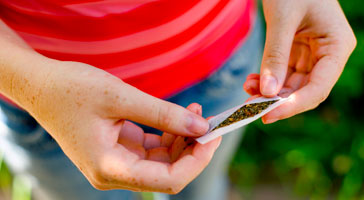
Many parents are savvy to the “peer pressure” and the “just say no to drugs” talk. As we know, it’s a very worthwhile conversation to have, and often. Let’s face it.
Seriously though, many parents are focusing the discussion on drugs which we typically associate with danger like marijuana, ecstasy, acid and cocaine, but, they may be missing out on even more accessible options that teens use to get high. What’s even scarier is that most are commonly posted online.
Did you know that there are many household items and over-the-counter drugs which kids can use to get high? Sometimes kids assume these items are “safer” than “street drugs,” but they can be just as dangerous.
Here are three of those discussed:
1. Nutmeg : No joke. Nutmeg isn’t just a spice in your kitchen cabinet — it can be a dangerous hallucinogen when smoked, snorted, or ingested in large doses.
Nutmeg in small doses when used in cooking is considered safe. Reports suggest the recreational use of nutmeg is not a new practice, and it dates back to the 1800s. Nutmeg contains a chemical called myristicin, which can cause hallucinations when taken in doses of up to two tablespoons.
Such amount of nutmeg consumption may lead to vomiting before any hallucinogenic effect can occur; still, it can lead to myristicin poisoning which can produce convulsions or heart palpitations.
Unfortunately, there is a wealth of online information, including videos, about whether or not nutmeg can “get you high.” This information is easily accessible with “how to” instructions to boot. The online contingent suggests that smoking nutmeg can lead to an immediate high, but consuming large quantities orally can take hours to manifest a “high” but last for days.
2. Cough Medicine: The slang term for abuse of cough meds is “triple C” (which stands for Coricidin Cough & Cold), or “Cordies.” Another street name for this drug is “skittles” because Coricidin comes with a bright red coating. It is upsetting to learn that younger children are sometimes convinced to try triple C because they may look harmless like a familiar candy.
According to a report Coricidin contains Dextromethorphan, which, when taken well in excess of recommended appropriate doses, may cause hallucinations or dissociation. It’s accessible and often shoplifted from the store; shoplifting has gotten so common, in fact, that some stores have moved them to behind the counter.
The dangers of using triple C are numerous, and the side effects of the additional chemical ingredients like antihistamines can compound the dangers. Dangers include, but are not limited to, seizures, brain damage, irregular heartbeat, and death.
NOTE: Anti-histamines (like Benadryl), sleep aids, and pain relievers (like ibuprofen and acetaminophen) may be abused in a similar way as triple c; swallowed in excess of the appropriate recommended dose, in an attempt to create a high or help with “feeling numb.”
3. Caffeine Drinks and Pills: Caffeine is a regular, seemingly innocuous fixture of our over worked society. We don’t think twice about it when drinking our morning coffee; but, in large doses caffeine gives a buzz or high. It is easily accessible to kids, and not regulated. Pills, like No Doz, or high caffeine energy drinks, like Red Bull, are often found in convenience stores and markets.
Many scary online forums advocate snorting several tablets at a time, whether to help you study for exams, get you high, or both. Caffeine abuse can lead to heart palpitations, dehydration, panic and anxiety attacks, and sometimes death. Unfortunately, some kids discover their first high inadvertently while trying to cram for exams, so talk with your teens about caffeine moderation and the risks.


